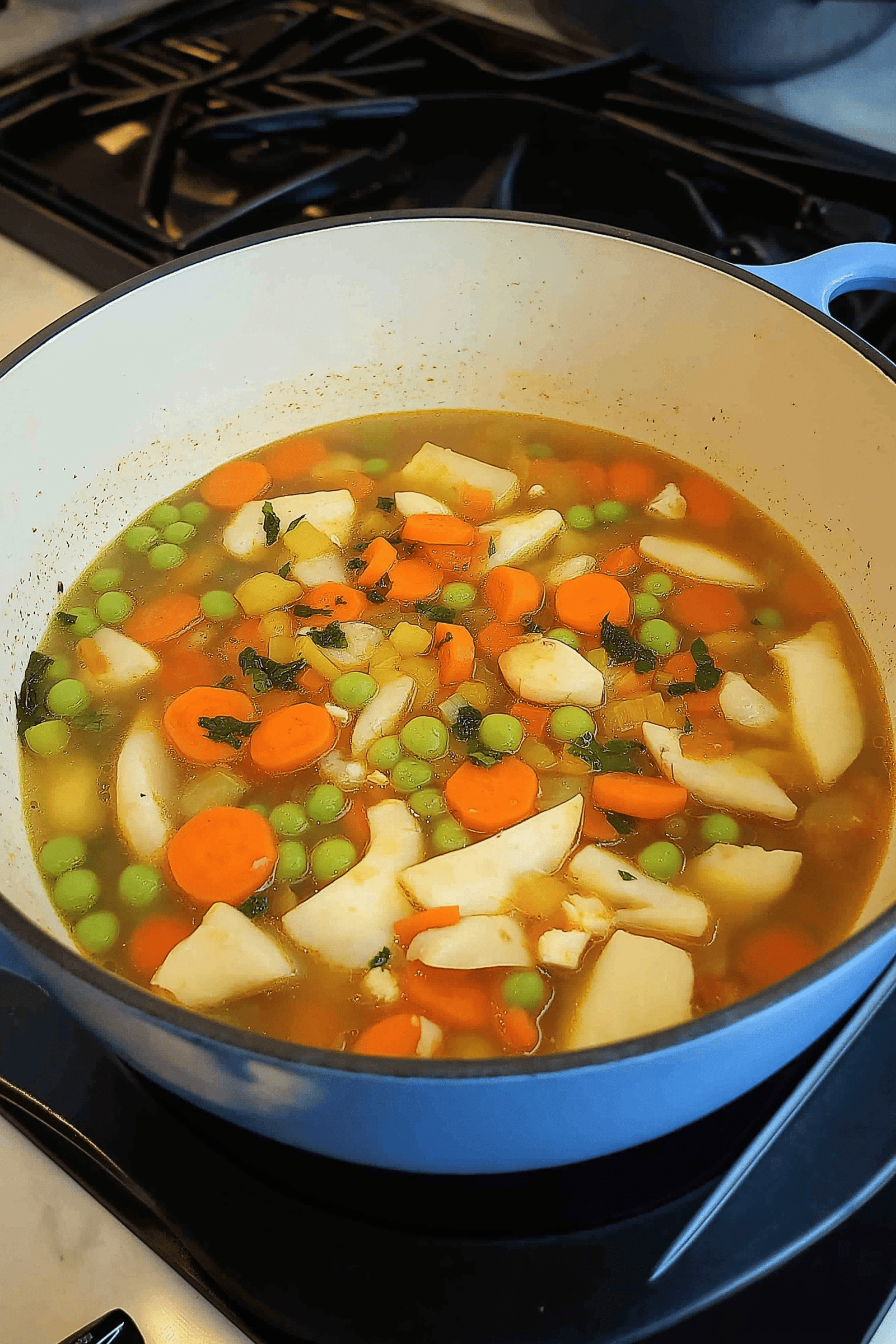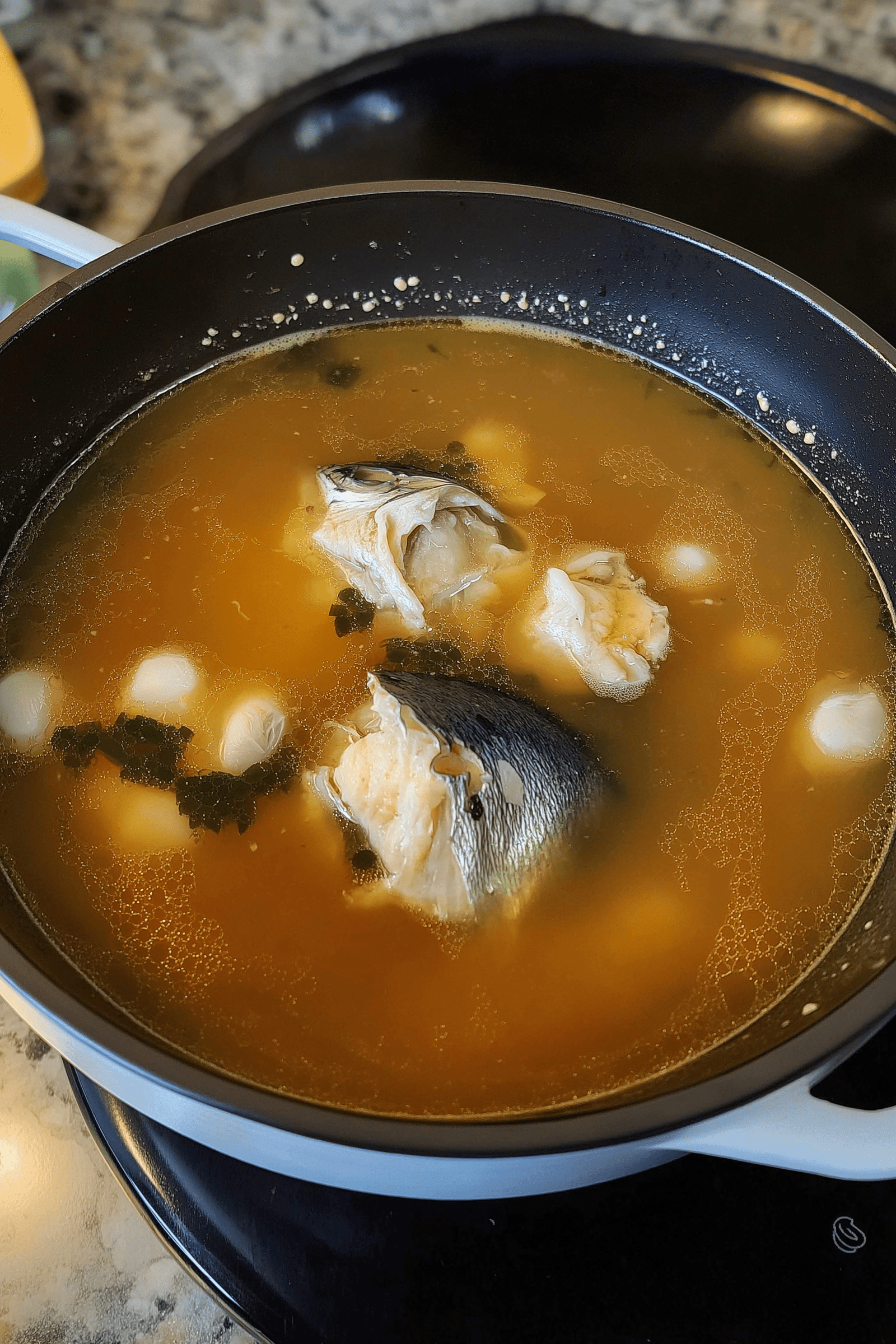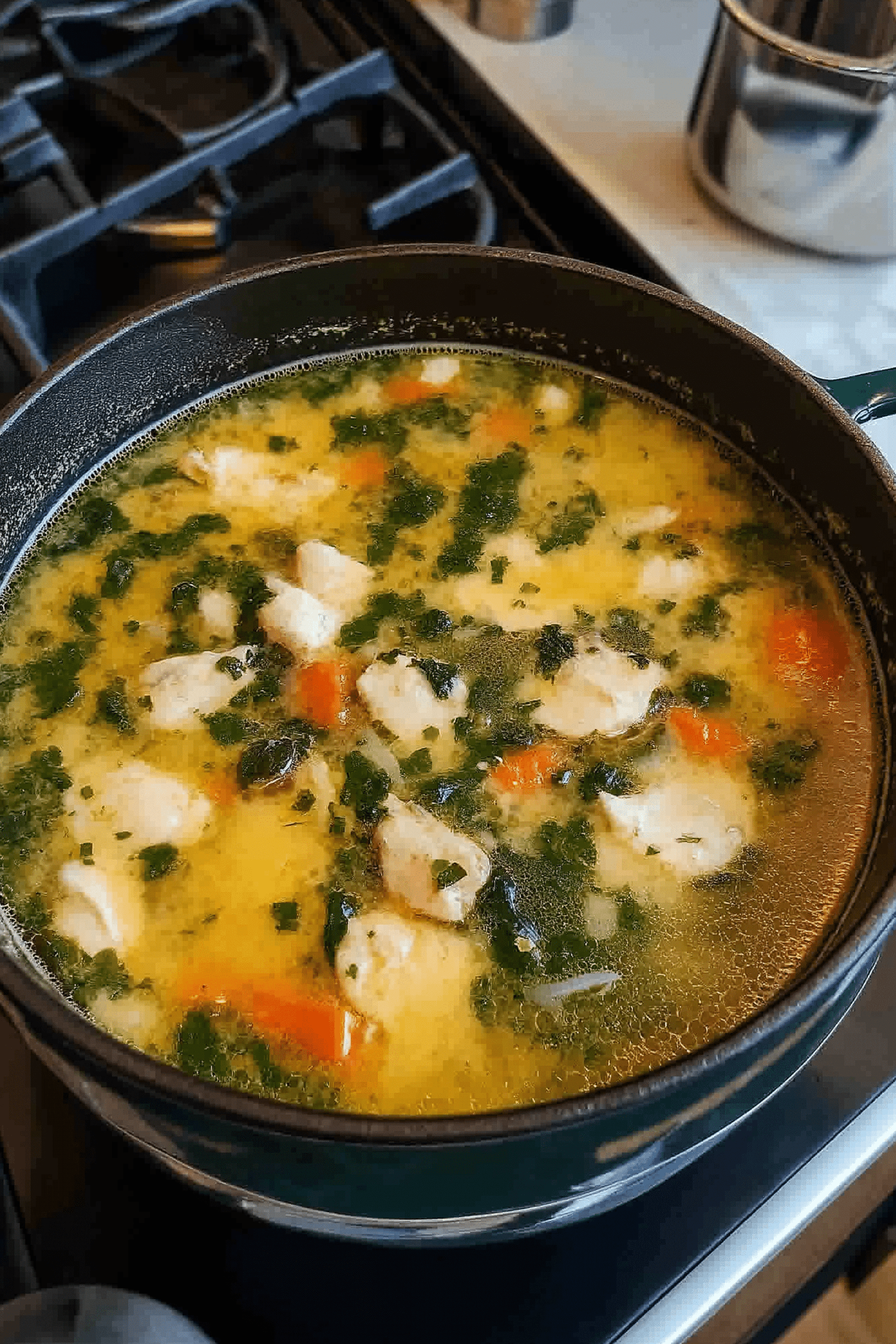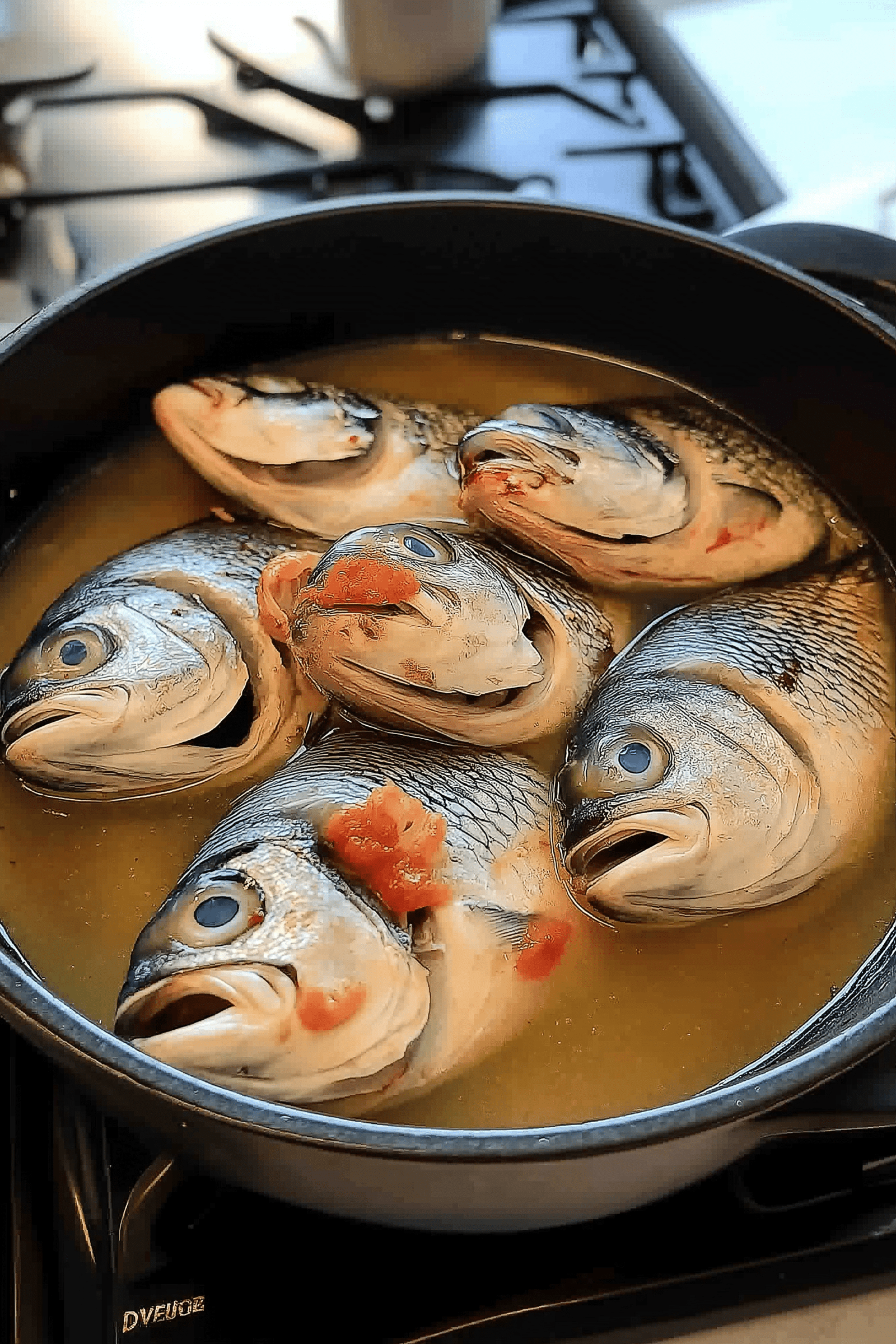I love cooking and have found many old recipes. But making my fish soup feels very special to me. One day, with lots of leftover salmon and a craving for something warm, I made Salmon Fish Head Soup. It quickly became a favorite in my home. It brings the tastes of Asia into my kitchen, feeling like a hug with its rich flavors. In just 40 minutes, I’ll show you how to make a broth that feels like the hug of a traditional fish head soup1.
Key Takeaways
- Discover a cherished traditional recipe from the heart of Asian cuisine.
- Learn to craft your own homemade fish soup for a comforting dining experience.
- Four comforting servings of a flavor-packed soup, perfect for family dinners.
- Health benefits abound with omega-3s and essential vitamins in this nourishing dish.
- Sustainable and resourceful, this recipe embraces the full utilization of fish for zero waste.
- Partner with local sources like Yakobi Fisheries to support sustainable fishing practices.

Introduction to Fish Head Soup
Fish head soup is more than just a dish in traditional Asian cooking. It’s a deep journey that links comfort eating with the art of cooking. This delicacy, with its rich seafood broth and aromatic spices, is a key piece of Asian cuisine. It offers flavors that both calm and excite those who taste it.
What Makes Fish Head Soup Special?
This soup is celebrated for its bold, savory taste. The magic of the dish comes from a simple mix of fish heads, herbs, and spices. It’s loved for being a warm comfort food across different places. Using the whole fish shows a care for sustainable cooking, which helps avoid waste and keeps meals nutritious.
Popular Variations Around the World
Fish head soup can be found in many styles worldwide. You might taste the spicy and sour tom yum in Thailand or the creamy soups with coconut milk in Malaysia. My cooking adventures have also led me to techniques like those from the Māori, using miso paste and coconut milk for a special taste (source)2.
Ingredients for Fish Head Soup
Making homemade fish head soup involves careful selection of ingredients. Knowing what you need increases the dish’s flavor and authenticity. Let’s explore the essential and optional parts that can make your meal stand out.
Essential Ingredients You’ll Need
- 1 bass groper fish head3
- 1/2 kg of bass groper fish3
- 400 g of pickled mustard greens3
- 1/2 kg of taro3
- 2 tablespoons of salt3
- 1 tablespoon of sugar3
- 1 tablespoon of chicken powder for flavor3
- 3 liters of water for the broth3
- 5 slices of ginger3
- 8 spring onion heads3
Optional Ingredients for Customization
To make your fish soup your own, add some optional ingredients. They bring new textures and tastes, making your dish special every time.
- Rice noodles, as a suggested addition for a fuller meal3
- A hint of Shao Xing Wine to enhance depth (2 tbsp)4
- Fried taro, for additional crunch and flavor; fry until golden before adding to the broth3
- Pan-fried pickled mustard greens for an extra pop of flavor; fry for 3 minutes before adding3
Cooking homemade fish soup is fun because you can make it yours. Feel free to play with the amounts and types of ingredients. This lets you match the dish to your taste and diet needs.
How to Prepare Fish Head Soup
Learning to make fish head soup starts with making a tasty broth. This brings a rich and delightful experience to your meal. We’ll discover how simple ingredients can turn into a delicious soup. This soup is not only tasty but also good for your health.

Step-by-Step Cooking Instructions
To keep the dish’s flavor and richness, follow these cooking tips carefully. Start by lightly frying the fish heads in oil and a little water. This step is key to bringing out their deep flavors, which make the broth tasty. It usually takes about 15 minutes to get the fish heads golden.
Then, add water to the pot with the fish heads. Throw in large pieces of onions, tomatoes without seeds, garlic, celery, and carrots. This mix adds both flavor and vitamins to your broth. Cover the pot and simmer on low heat for 30 minutes. This lets the ingredients blend perfectly together.
Once simmered, take out the fish heads, pick out the meat, and toss the bones. Put the soup and fish meat back on heat, you can add fresh herbs now, and simmer for another 15 minutes5. This step blends all the flavors with the broth. It also keeps the meal nutritious.
Tips for Preparing Fish Heads
Prepping fish heads right is key to the soup’s taste and nutritional value. Be sure to clean them well, getting rid of scales and gills that make the broth bitter. Use fresh fish heads for the most health benefits, like Vitamin A, iron, and omega-3 fats.
Salmon heads add a lot of flavor and fat, making the broth even better. You can find this suggestion in this recipe6. Red snapper heads are also great, adding flavor and being cost-effective7.
Always simmer the broth slowly; boiling too hard can mess up the fish and cloud the soup. A slow simmer keeps the broth clear and the flavor strong. It makes for a very tasty and enjoyable meal.
To sum up, paying attention to detail makes fish head soup superior. Following these steps and tips leads to a comforting, flavorful broth. It not only pleases your taste buds but is also packed with health benefits.
The Nutritional Benefits of Fish Head Soup
Fish head soup is more than just tasty. It’s packed with health benefits that strengthen the body. It’s rich in omega-3 fatty acids, vitamins, and minerals. This makes the soup great for a balanced diet.
Rich in Omega-3 Fatty Acids
Omega-3 fatty acids boost health, fighting inflammation and heart disease. Fish head soup, especially with salmon, is a top source of these fats. If you eat it regularly, it can lower cholesterol and prevent heart issues. These nutrients also support brain health, helping to protect against depression and anxiety8.
Vitamins and Minerals Found in Fish Heads
Fish heads are full of key vitamins and minerals. They provide vitamin A for clear vision and a strong immune system8. There’s also iodine, which keeps the thyroid healthy9. Plus, with calcium and potassium, the soup helps muscles work right and keeps the heart beating steadily, boosting heart health9.
Fish head soup is also good for new moms, as part of diets around the world after giving birth. It has top-notch proteins and crucial nutrients10. So, it’s not just good because it tastes nice. It helps with healing cells, thinking clearly, and keeping bones strong9.
Adding fish head soup to your meals can perk up metabolism and immune system. It may even cut down the risk of long-term illnesses like diabetes and arthritis8. Eating it is a tasty way to fill up on important nutrients, leading to a healthier life.
Popular Fish Heads for Soup
Exploring Asian cuisine means finding the best fish for your soup. Salmon is a top choice not just for its rich taste, but also because it supports responsible fishing. Using fish heads adds deep flavors to soups, a tradition cherished in many cultures11.
Best Types of Fish for Flavorful Soup
Salmon heads bring rich oils and a strong taste to soup stock12. They are widely used in Asian soups, making the broth richer. It might take 12 to 24 hours to prepare, but it brings out the salmon’s complex flavors12. Adding ingredients like wakame seaweed and mirin or white wine complements the salmon, enhancing the soup’s taste12.
Sustainable Fishing Practices to Consider
Choosing fish from sustainable sources is important. Responsible salmon fishing helps keep the oceans healthy and balanced. This respect for nature is key in Asian cooking. By picking sustainably sourced fish, you get a great meal and help protect the sea11. Plus, using fish heads, often thrown away, is good for the planet. It turns potential waste into a delicious part of your meal11.
For a taste of tradition, try making fish head soup. It’s an excellent way to use an often-overlooked ingredient11. Check out this simple fish bone broth recipe. Or, for a different type of soup, learn to make the flavorful chopt soup here11.
Cooking Techniques for Fish Head Soup
To make the best fish head stew, knowing different cooking ways is key. How you cook can change the stew’s flavor, texture, and quality a lot. We will look at boiling, steaming, and slow cooking to find out which is best for a great taste experience.
Boiling vs. Steaming: Which is Better?
Choosing between boiling and steaming for a tasty fish head stew matters a lot. Boiling helps pull out deep flavors and nutrients, making a seafood broth full of tasty goodness. You simmer the fish heads for 20 minutes to blend all flavors well into the broth13. Steaming, though, is gentler and keeps the fish soft but might not add as much flavor to the broth.
Slow Cooking for Enhanced Flavor
If you love deep flavors in your fish head stew, slow cooking is the way to go. It lets the flavors mix and grow over time, giving you a rich seafood broth. Slowly simmering the broth lets it soak up the spice aromas well, making it the best pick for rich and layered soup tastes.
| Cooking Method | Technique Description | Time Required | Suitable for Fish Head Soup? |
|---|---|---|---|
| Boiling | Submerge fish heads in water, simmer with spices and herbs | Approx. 20 minutes13 | Yes, for a rich broth |
| Steaming | Steam fish heads over boiling water | Varies | Yes, for preserving texture |
| Slow Cooking | Slow simmer at lower temperatures | Extended hours | Yes, for enhanced flavors |
Improving your seafood broth comes from trying out different recipes. For example, seeing how slow cooking improves a Texas Roadhouse Smothered Chicken might give you ideas for fish head stews. It’s about using cooking methods to transfer flavors better.
Traditional Dishes Featuring Fish Head Soup
Fish head soup is key in many cultures, especially in Chinese and Filipino cuisine. This soup brings rich flavors and connects us to long-standing traditions. We’ll explore how this dish features in popular recipes within these cultures.
Chinese Fish Head Soup Recipes
Chinese fish head soup is famous for its rich, aromatic taste. It mixes spices and ingredients like carrots, cabbages, ginger, and star anise. Not only delicious, it’s also nutritious, showing the depth of Chinese food traditions. Through this dish, we see how food transforms into an art, full of flavor and history.
Filipino Sinigang na Isda
Sinigang na Isda is a favorite in the Philippines, with its tangy tamarind broth. Including fish head, the dish balances sourness and rich fish taste with vegetables. It’s all about enjoying life’s flavors, making it a must-try at home.
Looking at these fish head soups, we see how cultures value this ingredient. From Chinese soups to Filipino Sinigang, these recipes are about more than food. They offer comfort and connect us to our roots.
Feeling adventurous? Try French Onion Soup Rice. It’s a creative mix of French onion soup flavor with rice. Check it out here.
Fish head soup is more than a meal. It’s a story of cultural identity, handed down, and celebrated across the globe.
Pairing Fish Head Soup with Side Dishes
When making an unforgettable meal, it’s key to pick the right sides. Fish head soup is rich and full of taste. The right rice and traditional Asian dishes can make the meal even better. I’ll show you some top choices that will make your meal stand out.
Best Rice Options to Serve
Choosing the best rice for fish head soup is vital. Jasmine rice is great because it has a subtle flower smell. It soaks up the strong flavors of the soup well. If you like something extra, try ginger rice. It’s spicy and matches the soup’s taste perfectly.
Experts say jasmine rice not only adds flavor but also makes the meal more authentic like Maeuntang. Also, using rice as a side dish is common in Asian meals. It’s a big part of how the meal looks14.
Traditional Accompaniments
For side dishes, it’s important to have variety and balance. Lightly cooked vegetables with a savory sauce add freshness. They also give a nice crunch. Bok choy or spinach are perfect. A cucumber salad with vinegar and sugar freshens your mouth for the next bite.
Add traditional garnishes like fried shallots or garlic for extra taste. Fresh herbs like cilantro or Thai basil add flavor. They’re key in many Asian meals14.
Keep these rice and side dish ideas in mind to highlight Asian cooking. They follow cooking traditions and make your meal better. Every bite will be something to remember.
Serving Suggestions for Fish Head Soup
Offering guests a warm bowl of fish head soup can make a memorable meal. The way you present it greatly enhances its charm as comfort food. You can serve this dish as a tasty starter or a filling main course. The presentation can turn a simple dish into a special dining experience.
Presentation Tips for an Appealing Dish
For a stunning fish head soup, focus on how you place the fish head. Keep it in the center of the bowl for a nice look. Adding garnishes is important for making the dish look good. Use things like chopped green onions, cilantro, or red chili for color and flavor. A little sesame oil adds a yummy shine.
Ideal Serving Sizes and Portions
Finding the right serving size is about being generous but sensible. A single fish head is enough for one large or two smaller servings. This way, everyone gets to enjoy the soup’s great flavor without feeling too full15. Serving the soup with rice and sides like kimchi makes a complete meal. It satisfies the craving for comfort food and showcases the soup’s rich taste15.
Here’s a summary of serving sizes and tips for a great fish head soup:
| Component | Quantity | Role in Presentation |
|---|---|---|
| Fish head | 1 per serving or 2 smaller servings | Central focus of the dish |
| Garnishes (Green onions, cilantro, chili slices) | 1-2 tablespoons | Add color and enhance flavor |
| Sesame oil | A drizzle | Add sheen and richness |
| Side dishes (Rice, kimchi) | 1 cup of rice, small bowl of kimchi per person | Balance and complement main dish |
These tips help make every bowl of fish head soup both delicious and beautiful. They capture the true spirit of comfort food in every bite.
Common Mistakes to Avoid When Making Fish Head Soup
Making a great broth for fish soup is both an art and science. Avoid common mistakes, and you’re on your way to perfection. Let’s dive into the key do’s and don’ts that impact your soup’s success.
Overcooking the Fish Heads
Overcooking fish heads is a big no-no, making the broth less tasty and the fish texture not good. To get the fish head just right, watch how long you cook it. Aiming for the perfect internal temperature, around 145 degrees Fahrenheit, ensures the fish is well-cooked but still flaky16. This care stops overcooking and keeps the flavors your soup needs.
Skipping Key Ingredients
Leaving out key ingredients can ruin your broth. Fresh herbs and spices add a lot to the soup’s taste. Use about 1 to 2 tablespoons of fresh herbs or 1 to 2 teaspoons of dried spices17. Also, put seasoning in when the fish is mostly cooked, to keep moisture and boost flavor16.
| Ingredient | Quantity for Flavor Enhancement | Optimal Addition Time |
|---|---|---|
| Fresh Herbs (e.g., parsley, cilantro) | 1-2 tablespoons | Add last 10 minutes of cooking |
| Dried Spices (e.g., paprika, turmeric) | 1-2 teaspoons | Initial stages of cooking |
| Fish Seasoning | To taste | When fish is 80% cooked |
Also, be careful with salt to prevent your soup from getting too salty. This often happens when veggies and grains soak up salt while cooking17. Add salt bit by bit and taste often to keep the flavors balanced17.
By following these tips, you avoid common errors and add a delicious dish to your cooking skills. Your next fish head soup will be a tasty mix of flavor and tradition.

Storing and Reheating Fish Head Soup
Storing and reheating fish head soup the right way keeps its great taste and smell. Let’s look at the best ways to make sure your soup is as good as when it was first made.
Proper Storage Techniques
Right storage is essential, whether you have leftovers or made your soup early. Store your soup in a sealed container in the fridge to keep it fresh and tasty. It’s best to eat the soup within 3 to 4 days for the best flavor18. Freezing is an option for longer storage, but it might change the taste and texture of the fish18. Using thicker fish cuts, like swordfish or tuna, can help since they keep moisture better18.
Best Methods for Reheating Without Sacrificing Flavor
When heating up fish head soup again, take it slow. Don’t use the microwave, as it can make the fish dry and smelly18. Warming it in an oven at low heat helps keep it moist and tasty18. Cover the fish with foil lightly to stop it from drying and control any fishy smells18. Remember, reheated fish won’t taste exactly like it did at first. You might want to lower your hopes and maybe add some fresh herbs or lemon to improve the flavor18. Also, turning leftovers into something new, like fish cakes or chowder, is a great idea. It uses up extra soup and keeps meals interesting18.
Conclusion: Enjoying Fish Head Soup
Fish head soup is a gem in Asian cooking, rich in history and flavor. It’s packed with vitamins and omega-3 fatty acids19. Enjoying a bowl not only means a low-calorie meal but also sharing a special moment with loved ones, as seen in Vietnamese culture19.
This dish does more than fill you up. It brings people together, creating memorable times around the dinner table.
Final Thoughts on This Culinary Treasure
This soup, with its tomatoes, offers both vitamin C and lycopene. It’s well-balanced in sodium and fiber too19. Research shows how healthy and flavorful each ingredient is19. Plus, it’s quick to make, taking about 30 minutes, making it perfect for busy cooks20.
Encouragement to Try Making It Yourself
I encourage you to make this delicious soup. It’s perfect for large gatherings, serving up to 20 people21. You’ll become the center of a joyful event, full of stories and laughter with every spoonful. It’s your chance to add to the rich tradition of Asian cuisine.

FAQ
What makes fish head soup a traditional Asian culinary delight?
Can I customize the fish head soup recipe?
How do I properly prepare fish heads for cooking?
What are the health benefits of consuming fish head soup?
Why is sustainable fishing important when choosing fish heads for soup?
Is it better to boil or steam fish heads for soup?
What side dishes pair well with fish head soup?
How should fish head soup be served to maximize its appeal?
What are common mistakes to avoid when making fish head soup at home?
How can I store and reheat fish head soup without losing its flavor?
How can I incorporate the traditional aspects of fish head soup into my own cooking?

Fish Head Soup
Ingredients
- 2 large fish heads salmon, snapper, or grouper cleaned and halved
- 6 cups 1.4L water or fish stock
- 1 medium onion diced
- 3 cloves garlic minced
- 1- inch 2.5 cm ginger, sliced
- 1 medium tomato chopped
- 1 carrot sliced
- 2 celery stalks chopped
- 1 teaspoon salt adjust to taste
- 1/2 teaspoon black pepper
- 1 teaspoon fish sauce optional
- 1 teaspoon soy sauce optional
- 1 bay leaf
- 1 teaspoon dried thyme or fresh thyme sprigs
- 1/2 teaspoon turmeric powder optional, for color
- 1 cup 240ml coconut milk (optional, for creamy version)
- 1 small chili pepper sliced (optional, for spice)
- Juice of 1 lime or lemon
- Fresh cilantro or green onions for garnish
Instructions
Prepare the Fish Heads:
- Clean the fish heads thoroughly, removing gills and excess blood.
- Rinse under cold water and pat dry.
Sauté Aromatics:
- In a large pot over medium heat, add onions, garlic, and ginger. Sauté for 2-3 minutes until fragrant.
- Add tomatoes, carrots, and celery, cooking for another 3 minutes.
Simmer the Broth:
- Pour in water or fish stock, then add fish heads, salt, pepper, fish sauce, soy sauce, bay leaf, thyme, and turmeric.
- Bring to a boil, then reduce heat to low and simmer for 25-30 minutes, skimming off any foam.
Add Final Ingredients:
- If using coconut milk, stir it in and let simmer for 5 more minutes.
- Add chili pepper for heat, if desired.
Finish & Serve:
- Remove fish heads and gently separate the meat, discarding bones. Return meat to the pot.
- Stir in lime juice, adjust seasoning, and garnish with fresh cilantro or green onions.
- Serve hot with steamed rice or crusty bread.
Notes
- For a Clear Broth: Strain the soup before serving.
- For Extra Flavor: Add shrimp or mussels during the last 10 minutes of cooking.
- Storage: Store in the fridge for 2-3 days, or freeze for up to 2 months.
- Best Fish Heads: Use salmon, snapper, cod, or grouper for the richest broth.




